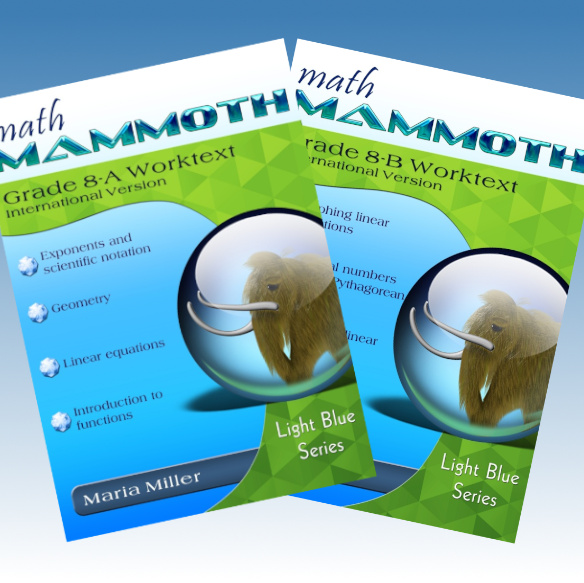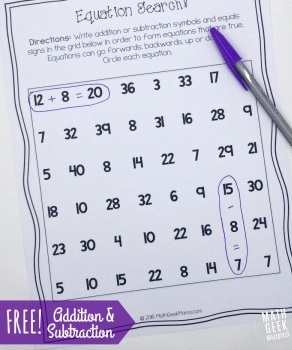
Welcome to my October edition! I don't know how many of you are in FL or other states affected by the hurricane messes but if so, I hope you are staying dry and doing alright! |
1. Math Mammoth newsWe now have INTERNATIONAL versions of four of the Blue Series books: Decimals 2, Fractions 1, Fractions 2, and Geometry 1. These are excellent for upper elementary and middle school students (grade/year 5 and up, 10+ year olds) who might need reinforcement of decimal and fraction arithmetic, and of basics of geometry.The international versions are all metric, are formatted to A4 paper size, and use British English spelling. Find the "Add to cart" button in the right side bar of these pages, right below the button for the U.S. version. The Blue Series book Linear Equations 1 has been updated and revised. It now contains lessons from my revision work on grade 7 materials, and it no longer overlaps so much with the book Linear Equations 2 (which is for 8th grade). If you have purchased a digital version in the past, or have purchased a bundle that contains it, you can get a new download link here. We have now published Math Mammoth Grade 8, international version!😀 It is available both as digital and print versions. This curriculum is essentially the same as the U.S. version of Math Mammoth Grade 8, only customised for the international audience in these aspects:
I started homeschooling my son halfway through second grade for dyslexia. We finished 2nd Grade, Light Blue, Math Mammoth by the end of that summer. It was the perfect precursor to 3rd Grade Math Mammoth. I often recommend 2nd and 3rd grade Math Mammoth to older students who are struggling due to missing some of the basics, especially those students who are visual learners. We continued Math Mammoth through the Pre-Algebra curricula. My son went back to public school in 7th grade in the accelerated math class. He just finished 8th grade with an A+ in high-school-level Algebra. He will take Geometry as a freshman. I highly recommend the earlier grades of Light Blue Math Mammoth for anyone of any age who is struggling with math mastery. |
2. Can AI do math?I decided to test some AI bots' ability to do math, again. Here's a word problem from a new product we're working on. I put that problem to both ChatGPT and Gemini to see if they could solve it. Then I also asked them whether they thought the problem was realistic. 😀THE WORD PROBLEM: For unknown reasons, Mathy the mammoth has ordered six trucks full of blueberries to be dumped in his backyard, with a total of 7,830 kg of blueberries. Each truck would haul the same amount. However, the second truck accidentally dumps a third of its load at Mathy's friend's house, before bringing the rest to Mathy. How many kilograms of blueberries did Mathy actually get? The results are shown in the images. Quite interesting! Gemini: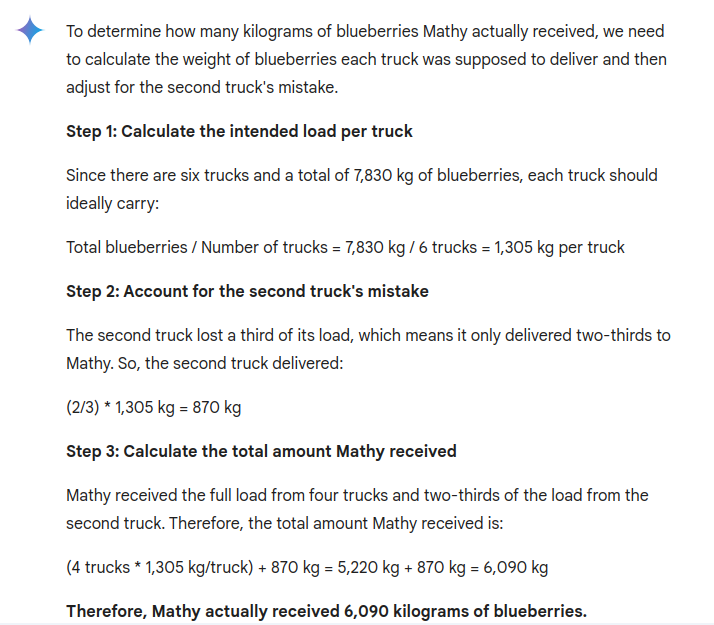 ChatGPT: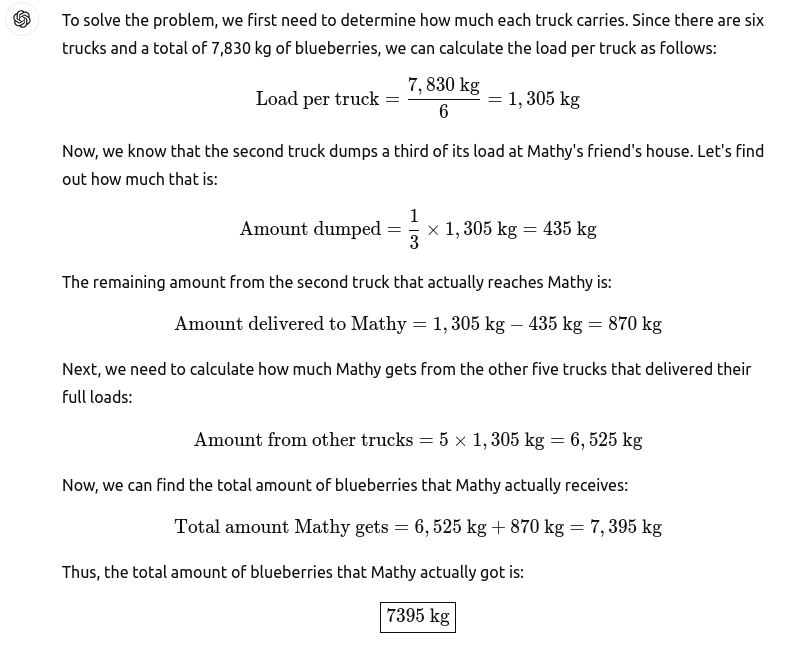 Can you tell which AI system got it right or did neither? Then I also asked each system whether it thought the problem was realistic: Gemini: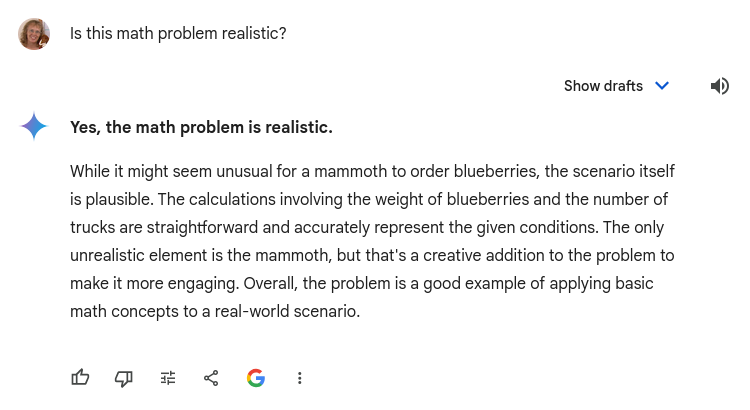 ChatGPT: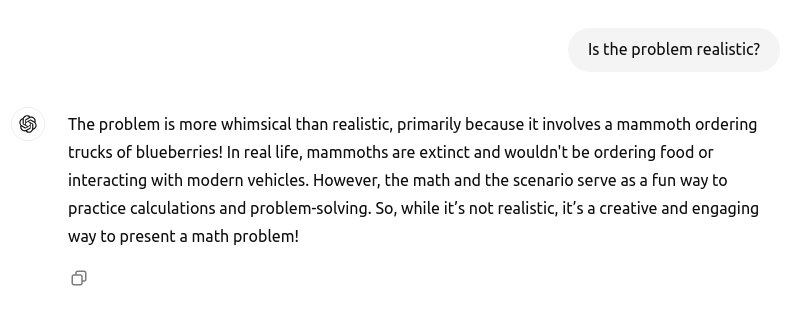 Tell you what, we checked, and the problem is not realistic... if it is about dump trucks, the amount of blueberries would need to be in the hundreds of thousands of kilograms... but the problem is intended for 4th grade and to be solved with long division which limits the size of the number we want to use. However, I do feel it's not a problem as it is a very fantastic/whimsical scenario. I got several comments on this on FB. Here's one of them: Word problems are super hard for AI. My husband is consulting on a couple of projects teaching AI how to understand math problems and they have hundreds of people working on it.Someone on FB asked: "But what does this mean for math teachers who are trying to understand whether their students can actually do math or whether they just put everything up for AI to work out?I imagine it can make math teachers' lives more challenging. One thing though, as seen here, Google's Gemini got the wrong answer. It will be hard to trust these AI bots for math word problems. Which means math teachers could even design an assignent about that fact... "Make a word problem and find out what the different AI bots give as an answer, and analyze those answers." On the other hand, AI or not, the desire to learn or to skip learning and trying to get by, IMO starts with how the child is raised from small baby onward and what influences they have had during childhood and in elementary school. You might also check the position that the National Council of Teachers of Mathematics (NCTM) takes on AI and mathematics teaching. They say: "Teachers must tell students to be very skeptical about AI results, especially about the unique challenges of using tools that may have been trained on biased datasets."So, really, at least at this point, using AI for math problems means you have to know math well, so you can evaluate whether AI gave you the correct answer or not. For very simple elementary grade math, maybe it gets those correct... but that age children shouldn't be using AI anyway. |
3. Grading testsSomeone asked a question about GRADING the chapter tests and wanted my opinion.As a current homeschool teacher/parent, but also former public school teacher (14 years! 😀), I am used to offering some sort of corrections in my prior classroom. But not sure what to offer (grade wise) in my homeschool.My answer: With my own children, I had them do corrections in tests for partial points. They could try to answer the question in a test the 2nd time, and if they got it right, they got 1/2 the points they originally could have gotten. Whether to do that or not, I feel depends on the child and how they tend to react and respond. I'd like to also mention that one scientific study found that giving VERBAL FEEDBACK on a test was more effective and more encouraging than point counts. This article might also be helpful: Growth mindset & how to (and how NOT to) praise our students It will be good to praise their hard work and effort, and not put a lot of value to point counts of any kind. |
4. Filling in Math Mammoth files on a tablet or computerDid you know you can go paperless and fill in the Math Mammoth files on a computer or tablet device?One way to do it is to take a screenshot and then write/draw on it. Another way is that the student can fill in Math Mammoth PDF files using the comment/annotation tools present in many PDF apps. These tools typically allow you to add text and to draw lines, circles, and other shapes.
Yet another option is to fill in the PDF file using online tools, such as DocHub.com or Kami. Kami also works for PDF files inside Google Classroom. If you know of others, let me know, and I can add them to the FAQ page. important note: Remember to save a copy of the PDF file somewhere, before your child or student starts modifying the file. |
5. Addition and Subtraction Equations from MathGeekMamaThis worksheet looks like fun! MathGeekMama says, "... last week I created an “addition and subtraction equation search” to help her review and practice addition and subtraction with one and two digit numbers. This is great for kids in kindergarten, first grade or second grade!"https://mathgeekmama.com/addition-subtraction-equation-search/ |
6. Just for fun!
Thanks for reading! 🙂 Feel free to forward this issue to a friend/colleague! Subscribe here. Till next time, Maria Miller |
| Complete curriculum | Math games and interactive practice | Math Mammoth freebies | New to MM? Start here |
| Privacy & your personal data | Consider the Ant | Blue Series: For filling in gaps |
